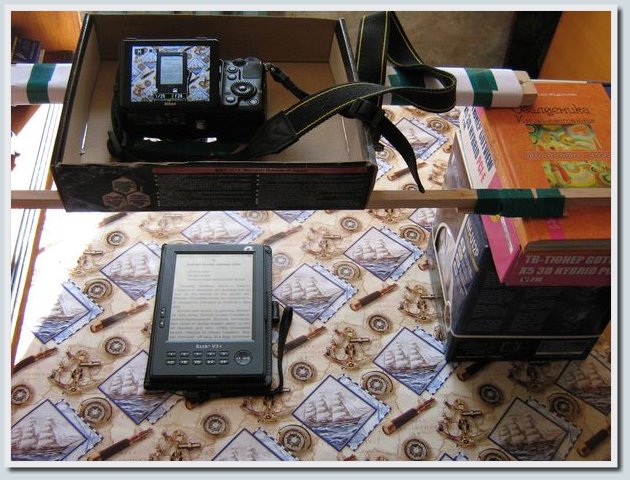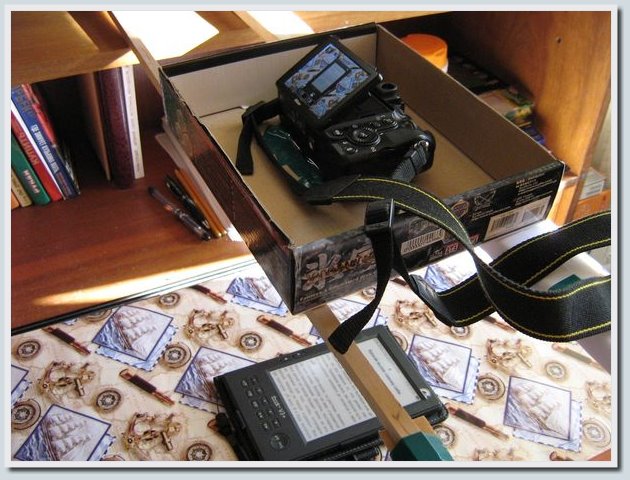A simple solution for vertical shooting devices and other tricks when creating reviews

In my first two reviews of readers ( PocketBook Basic New and PocketBook Touch ), I photographed the described devices with my hands, and made a slideshow for these reviews by combining screen shots obtained by software and real photos of devices. In these reviews, the picture, which was taken as the base for the frames of the slideshow, had to be taken while holding the camera in the position as close as possible to the vertical (the lens is directed downward on the table). Even then, I imagined that the next step was to use a tripod or some kind of tripod analogue, which would give me the opportunity to use real photos in a slideshow.
While working on the next review, I already had a more serious tool for creating high-quality images - the Nikon Coolpix P300 camera, which I was kindly provided by Nikon Ukraine. This time I decided to approach the creation of the slideshow more thoroughly. At first, I was looking for a tripod suitable for vertical shooting for a long time, but in the end I got an idea how to do without it.
The essence of the idea is extremely simple: put something like a lid on a small box on top of two wooden planks, cut a hole for the lens in this “camera stand” and take pictures. In the room in which I photographed the devices for review, next to the table there is a bookcase, on one of the shelves of which I laid wooden planks, on which I placed a stand under the camera with the camera itself. Under the opposite side of the planks, I put boxes from other large devices and several books.
Below I’ll talk in more detail about creating pictures for a slideshow, show some features related to creating a slideshow in the form of gif-animations, and also talk about possible ways to use this lowtech-analog tripod in some other areas. Caution, traffic!
Creating a stand for the camera
While working on a review of the Assistant AE-601 reader , I started looking for a suitable camera stand. The material for the stand should be durable (thick cardboard or a combination of cardboard and plastic), for the Nikon Coolpix P300 camera, while digging through the rubble, I found a box for the silent fan Noctua NF-P12. He put the camera on the stand, outlined the area of the lens and, using scissors, a knife and electrical tape, built what was needed. Making reviews of Amazon Kindle and Nook Simple Touch readers , I already had a more serious camera - Nikon Coolpix P7100 , which I made a stand for separately (a larger lens, a larger camera).
The pedestals for the Nikon Coolpix P300 and Nikon Coolpix P7100 look as follows: By placing the stand for the camera on the slats, you can adjust the height by placing additional books. Also, for reliable fixation of the planks it can be useful to put a couple of books on the planks on top. Below I give a couple of photographs of how the device for vertical shooting with the Nikon Coolpix P7100 camera looks like. In the above photographs, you may notice a rotary screen in the Nikon Coolpix P7100. This feature was very useful to me when I was shooting video for Kindle and Nook Simple Touch reviews (if you shoot without an assistant, the rotary screen is simply irreplaceable!).




Creating Pictures for a Slideshow
Taking photos for the review of the reader from Assistant, I have not thought of using a timer yet. But in the next two reviews, this camera chip has already been actively used. It is convenient to set the timer for 10 seconds, it may be possible to fix this option for each shot, I did not find such a setting, so I turned on the timer for each shot individually.
The procedure for creating pictures for a slideshow with a Nikon Coolpix P7100 camera using a timer, see below:

Folder on Dropbox
Slideshow Training
Photographing the slideshow reader using the above-described device (the reader is in one position, the information displayed on the device’s screen is different), the device’s screen was the real distinguishable difference in the pictures. However, creating a gif slideshow of such frames, the size of the created file was a bit heavy.
At first I thought that this was due to the oversized duration of the display of each frame of the slideshow, but experimenting, I realized that even for the eyes the pictures seem the same (except for the screen area of the device), but the computer perceives the information in these graphic files as different. Thus, to save space, I went to the option of working with the frame (we use a basic photo, in which we replace only the screen area for slideshow frames).
The training process for the slideshow in Ulead Photoimpact 12 , as well as the procedure for creating a slideshow of these frames are shown below in the form of a video.
Also, the algorithm for creating a slideshow from ready-made frames, I already showed the video instructions and illustrated instructions for working with Ulead GIF Animator 5.
Video recording
The device described in this habratopik is also well suited for self-creating video reviews. Putting the camera on the stand and turning on the recording, you can show the capabilities of the described device and the chips available in it (the camera is fixed, hands are free). Video clips for reviews of readers from Amazon and from Barnes & Noble I shot just like that. I would also like to note that an important bonus when shooting devices vertically with this device is the presence of a rotary monitor in the camera. If there is no such monitor, it will be problematic to remove the tested device while sitting at the table.
In the case of my reviews, I used a Nikon COOLPIX P7100 camera to shoot videoswith a swivel monitor, you can evaluate the video quality in this and this video. An additional feature of this camera is a fast lens, which makes it possible to adequately shoot without a flash in limited light conditions (this feature is useful if you plan to photograph devices such as tablets and monitors and want to avoid glare in photos).
Use of the device for vertical shooting in other areas
In addition to demonstrating the capabilities of various useful devices, the proposed device (in conjunction with the camera) you can also use in other areas. You can show the assembly and disassembly of devices, give lessons in radio electronics, teach calligraphy and drawing, make instructional videos on needlework (embroidery, weaving from beads, origami) and much much more. For me personally, the solution proposed above turned out to be useful, I hope, and the information from this topic will be useful to you in some way. Thank you all for your attention, I wish you good luck and success in your creative endeavors! UPD: Also, you may be interested in an article related to lighting settings when photographing devices - “High-quality photography of the gadget at home . ” Thanks for the tip,

tbicr !
